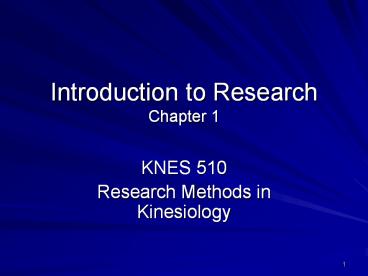Introduction to Research Chapter 1 PowerPoint PPT Presentation
1 / 28
Title: Introduction to Research Chapter 1
1
Introduction to ResearchChapter 1
- KNES 510
- Research Methods in Kinesiology
2
Research and Truth
- There is no truth!
- Separation of science, philosophy and religion
- Aristotle, Plato, Socrates
- Einstein-dice
3
(No Transcript)
4
(No Transcript)
5
Nature of Research
- Systematic plan, identify, design, collect
data, evaluate - Logical examine procedures to evaluate
conclusions - Empirical decisions are based on data
(observation) - Reductive general relationships are established
from data - Replicable actions are recorded
6
(No Transcript)
7
Unscientific Methods of Problem Solving
- Tenacity
- Intuition
- Authority
- The rationalistic method
- The empirical method
8
Scientific Method of Problem Solving
- Step 1 develop the problem (define and delimit
it) - identify independent and dependent variables
- Step 2 formulate the hypotheses
- the anticipated outcome
- Step 3 gather data
- maximize internal and external validity
- Step 4(5) analyze and interpret results
9
Applied Research
- Montoya BS, Brown LE, Coburn JW, Zinder SM.
Effect of warm-up with different weighted bats on
normal baseball bat velocity. Journal of Strength
and Conditioning Research. 23(5)1566-1569, 2009. - Step 1 develop the problem
- identify independent and dependent variables
- Step 2 formulate the hypotheses
- the anticipated outcome
- Step 3 gather data
- maximize internal and external validity
- Step 4(5) analyze and interpret results
10
Basic vs. Applied Research
- Basic research type of research that may have
limited direct application but in which the
researcher has careful control of the conditions - Applied research type of research that has
direct value to practitioners but in which the
researcher has limited control over the research
setting
11
Continuum of Basic vs. Applied Research
- Level IBasic research
- Goal Theory-driven
- Approach Laboratory
- Level IIModerate relevance
- Goal Theory-based using relevant movements
- Approach Similar to real-world task or setting
- Level IIIApplied research
- Goal Immediate solutions
- Approach Real-world settings
12
Experimental vs. Nonexperimental Research
- Experimental research
- Treatments are given to subjects
- Cause-and-effect questions
- Nonexperimental research
- Treatments are not given to subjects
- Participants are observed as they naturally exist
13
Experimental vs. Causal-Comparative Studies
- Researchers may not be able to conduct
experimental research due to ethical or legal
concerns, etc. - Examples
- physical activity and heart disease
- anabolic-androgenic steroids and liver cancer
14
Experimental vs. Causal-Comparative Studies,
contd
- Steps in causal-comparative (ex post facto)
studies - Observe and describe some current condition
- Look to the past to determine cause(s)
15
Types of Nonexperimental Research
- Causal-comparative
- Survey (poll)
- Sample vs. census
- Case study
- Longitudinal
- Correlational
- Historical
16
Quantitative vs. Qualitative Research
- Quantitative data are gathered such that they
can be quantified and subjected to statistical
analysis - Qualitative data are gathered such that they
can be analyzed through informed judgment
17
Quan vs. Qual
18
Variables in Experimental Studies
- Independent variable
- Variable that is manipulated (treatment is
administered) - Dependent variable
- Effect of the independent variable
- Simplest study has one independent variable and
one dependent variable
19
Variables in Experimental Studies, contd
- Effect of Isocaloric CHO vs. CHO-Pro Supplements
on Time-to-Exhaustion (Kristy L. Richardson,
Masters thesis, CSUF) - A 2 x 2, time (first test to exhaustion, second
test to exhaustion) x supplement (CHO vs.
CHO-Pro), repeated measures ANOVA was used to
compare the difference in time-to-exhaustion
20
CSUF Department of KinesiologyDescription of
Thesis
- Thesis written product of a systematic study of
a significant problemThe finished product
evidences originality, critical and independent
thinking, appropriate organization and format,
and thorough documentation - Creates new knowledge, extends existing knowledge
21
CSUF Department of KinesiologyDescription of
Thesis
- Format of thesis
- Five-chapter format
- Introduction
- Review of Literature
- Methods
- Results
- Discussion
- References
- Tables and figures
22
CSUF Department of KinesiologyDescription of
Thesis
- Journal format
- Similar to traditional format with some
differences (i.e., the review of literature is
part of the appendices) - Thesis committee one chairperson and two
members - Use of human subjects requires submission of
application to the CSUF Institutional Review
Board (IRB) prior to collecting data
23
CSUF Department of KinesiologyDescription of
Project
- Project disseminates theoretical material for
the practitioner or layperson in a given field - Project committee project chairperson and one
committee member - Typically in the form of a manual, brochure,
videotape, handbook, etc. - In addition to the project, a written review of
literature is required
24
CSUF Department of KinesiologyDescription of
Thesis and Project
- Proposal-intro, summary of lit review, methods
and stats (slides) - Defense-same as above with results, discussion,
tables and figures
25
CSUF Department of KinesiologyDescription of
Comp Exam
- Comprehensive exam provides the student with
the opportunity to synthesize and articulate the
knowledge acquired throughout the graduate
education and helps in preparing the student for
his or her chosen profession
26
CSUF Department of KinesiologyDescription of
Comp Exam
- The student is required to complete the written
comprehensive examination in the major area of
academic concentration and minor - The examination will be 3 hours in length for the
major and 1 ½ hours for the minor - The faculty member responsible for the specific
section determines the number of questions - One question examining research design and/or
statistics is included in the major area
27
CSUF Department of KinesiologyDescription of
Comp Exam
- If all committee members are satisfied with
written portion, a 90 minute oral exam is
scheduled at least two weeks after written - Further questioning on major/minor areas and
statistics research design
28
Next Class
- Chapter 2
- Get an article for your lit review
- Print out entire article
- Write (one page)
- Abstract
- Problem
- Hypothesis

